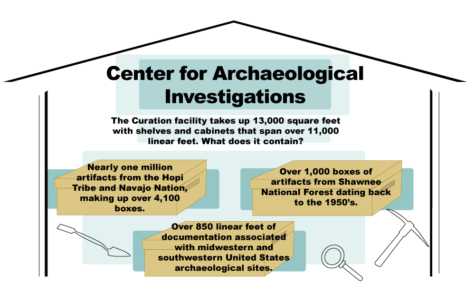Archaeological center would hit ‘rock bottom’ after cuts, director says
April 27, 2017
Mark Wagner is the only employee who shows up at work anymore.
He is the only staff member of the university’s Center for Archaeological Investigations, which has lost 80 percent of its funding in the last 10 years. The center’s staff has dropped proportionally — to one from nine — since 2007.
“We are essentially down to bare bones, or rock bottom, in funds,” Wagner said.
Advertisement
Wagner, the director of the research center, said the organization has been weening off university funds for the past four years in preparation for steep budget cuts. Since 2011, the money from the university has dropped from $30,000 to $10,000, which Wagner uses to pay basic expenses for running the office.
The Center for Archaeological Investigations is one of 15 centers or initiatives SIU’s non-academic prioritization committee suggested could become self-supporting with the goal of eliminating state funding by 2022.
The Daily Egyptian is publishing a series of stories to examine the effect those proposed cuts would have on the university community. This is the eleventh in the series.
The non-academic prioritization committee suggested cutting $90,004 of state funding from the center’s budget, which Wagner said is over 90 percent of their funding and would close the facility.
“I expect that will dip into my salary and our curator’s, so we’ll have to move over to anthropology full time,” he said.
Wagner also said the committee never consulted him on the funds the center could stand to lose.
“No one even asked what our mission was,” Wagner said. “I just hope in the future there’s better dialogue going to higher administration as more cuts come.”
Advertisement*

Since July 2015, Republican Gov. Bruce Rauner and Democrats who control the state Legislature have failed to come to an agreement on a state spending plan. In light of the state’s historic budget impasse, public universities are considering ways to continue operations with the assumption that some funding could be cut permanently.
Two stopgap measures passed in 2016 totaled $83 million of financial support for the SIU system. Those funds, for the most part, were used to pay the bills from the 2016 fiscal year. The university started the 2017 fiscal year “basically back at zero” and is dipping into the reserves once again, SIU President Randy Dunn has said.
The 15 institutions or centers identified in the non-instructional prioritization committee’s report suffered a permanent 10 percent reduction in state funding in fiscal year 2016. Others saw additional cuts in the 2017 fiscal year.
Dunn said on March 29 the Carbondale campus should cut at least $30 million in spending and should consider declaring a short-term financial emergency. Interim Chancellor Brad Colwell released a statement in response detailing the cuts at the campus level, which includes $1.2 million from partially self-supporting units like the archaeological center.
The cuts outlined in Colwell’s statement are for the 2018 fiscal year and are based in part on proposals for long-term efficiencies such as those in the non-academic prioritization report.
Wagner said the center offers research opportunities for graduate and undergraduate students, which is “extremely attractive” to prospective students.
The center currently has 27 active research projects. These projects usually bring in around $250,000 to the university, and 30 percent of those funds goes to the chancellor’s office, Wagner said.
Alice Muntz, a graduate student from Chicago studying anthropology, said the archaeology center is the reason she came to SIU for graduate school.
“The anthropology department is strengthened by the center,” Muntz said. “It’s what attracts students to the school.”
Muntz first came to SIU as an undergraduate student in 2011 as a part of the summer field school program which is offered through the center. Muntz said once she saw the facility, it solidified that archaeology was what she wanted to do.
During her time at SIU, Muntz said the total amount of projects she has worked on is “incalculable,” but she has worked on three major research projects and will be teaching in the summer field school program this year.
Muntz is currently doing research and analysis on some of the center’s 10,000 archives, which span from Navajo valuables to fossils in the Shawnee National Forest. Muntz’s current specialization is in prehistoric ceramics that the center keeps in storage.
“Cutting funding will only hurt us in the long run,” Muntz said, adding that the ability to offer undergraduate research “is huge in our world.”
Andrew Vancleve, a senior from Springfield studying anthropology, is one of the center’s undergraduate research assistants. Vancleve and his partner, Hannah Ward, had their first research project this semester through the center.
“It’s incredible being able to do this research as an undergrad,” Vancleve said. “I didn’t think I’d be able to do any type of research until grad school.”
Vancleve and Ward did ground-penetrating radar analysis at Fort Kaskaskia, a historic site in Ellis Grove, and planned excavation sites where underground artifacts showed up on radar.
“This was serious archaeology that we did,” Vancleve said. “It’s exactly what we will be doing in the real world.”
Wagner said the center’s goal is to support the anthropology students. Even though the center is supported mostly by external grants, the proposed budget cuts would still hinder the center from achieving its mission.
“We’ve been getting students jobs since 1978,” Wagner said. “That should be taken into account before funding is cut any further.”
Staff writer Olivia Spiers can be reached at [email protected], 618-536-3325 or on Twitter @_spierso.
To stay up to date with all your SIU news, follow the Daily Egyptian on Facebook and Twitter.
Advertisement






